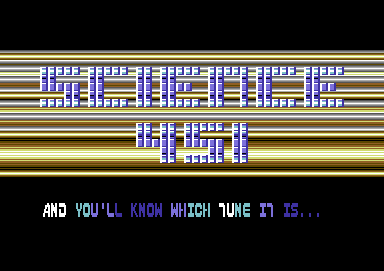|
| |
Credits :
SIDs used in this release :
Download :
Look for downloads on external sites:
Pokefinder.org
User Comment
Submitted by TheRyk on 19 July 2022
Imho Gaunt at the top of his C=64 musician career, man, how often did every part loop back in the late 80s :D
also solid code by K XII
PS: and boy, that Fred Gray dude...! |
User Comment
Submitted by HBH.ZTH on 27 September 2015
This applies to the last part of this demo, all code and design by Karl XII. Made in the beginning of 1988 it is the first demo using what was later termed the Tech-Tech effect, but it was not claimed to be anything in the scroll text, except it "being cool" :D Anyway he was first, even though he did not know it at the time. I have so far not found any earlier efforts to make a full tech tech - beyond the 8 pixel wide one gets from the $d016 register alone, that effect have been used since '86. The effect is about how to break the 8 pixel window, at least 16 pixels wide :)
The principal is the same be it a character logo or bitmap image, they both use a stable raster IRQ adressing the x-scroll register ($D016) movements over the 8th pixel is done by changing the data for both $DD00 and $D018 on each raster line, fetching data from a sinus table (using same size as the tech-tech routine), enables the logo to move independently in x scroll, 32 pixels wide (or more using bank switching at $DD00) and the logo appears to bend smoothly along the plotted sinus data.
Approach to character set tech-tech 128 pixels wide; copy the logo data into 8 memory locations, each with an 8 pixel shift of the data to appear 8 pixels to the right, which is 16x8=128 pixels wide. First one locate the 16 memory locations THEN copy the graphics data into each of the 16 locations, they are all identical except for the shift in +8 as each location is filled with graphics data.
An init routine could include something like this: LDA $0800,X, STA $2008,X, STA $2810,X, STA $3018,X +++ etc.
For full screen size tech-tech it's bitmap mode, using bank switching by addressing the register $DD00 together with $D016 and $D018. Maximum bitmaps images in the memory is 8 equals a 64 pixels radius, but no room left for code, music, etc. However a 6x8=48 pixels wide window frees up memory for other effects and music. One bitmap image swallows 8Kb memory!
Full screen bitmap mode is what's defined as being THE real tech-tech. It was conceived Spring of 1988 by Moonray & Omega Supreme.
Moonray had a vision of the effect in his minds eye. As usual he did not code anything before all routines was mapped out in detail in his mind, by visualizing the code that made it possible.
Omega started out coding oldskool using epyx fastloader - which have no real m/c monitor that let you edit the commands, in stead you had to write it directly into memory like a9, 00, 8d, 20, d0, 8d 21, d0, etc. Which should list as: lda #00, sta $d020, sta $d021, etc. You have to know the opcode for each command. The opcode for STA is: 8D then the 16-bit address in low & high bytes follows making a direct memory adress; in this case $d020 (border colour) value of zero will turn it black. The opcode for LDA #00 is: a9, 00. You get the idea - it's a lot of shit to remember by heart. It breeds a special kind of programmer, one that submerge into the code and becomes the code and thinks like a computer. |
|
|
|
 | Search CSDb |
 |
|
 | Navigate |  |
|
 | Detailed Info |  |
|
 | Fun Stuff |  |
· Goofs
· Hidden Parts
· Trivia
|
|
 | Forum |  |
|
 | Support CSDb |  |
|
 |  |
|


